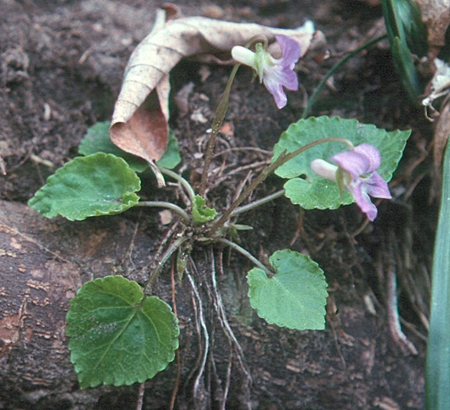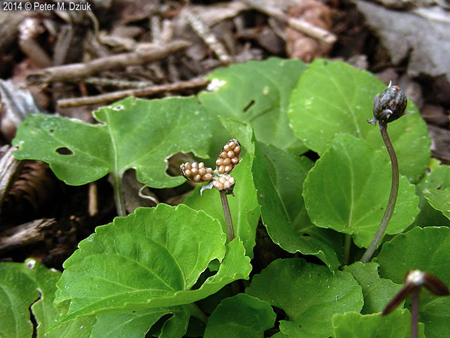Viola selkirkii Pursh ex Goldie
Common names:
Great-spurred Violet, Selkirk's Violet
Synonyms:
Viola selkirkii Pursh ex Goldie, Edinburgh Philos. J. 6: 324. 1822. TYPE: [Canada], Montreal, [no date], [J.] Goldie [s.n.] (LECTOTYPE (designated here): K000370205, internet image!).
Viola umbrosa (Wahlenb.) Fr., Novit., edit altera: 271. 1828
Viola kamtschatica Ging., Linnaea 1(3): 406. 1826
Description:
Acaulescent rosulate perennials from somewhat thick rhizome, ≤ 10 cm tall; foliage and peduncles green, upper surface of leaf blades dark green, glabrous except for scattered appressed hairs on upper surface of leaf blades; stipules adnate to petiole for up to 1/2 their length, glandular-dentate; leaves widely spreading to prostrate, leaf blades undivided, largest ≤ 50 × 40 mm, ovate to subreniform, base deeply and narrowly cordate, inner edges of basal lobes commonly attingent or overlapping in life, margins crenate (rarely crenate-serrate), eciliate, apex sharply obtuse or apiculate; chasmogamous peduncle held above leaves; chasmogamous flower ≤ 15 mm; calyx glabrous, eciliate; lowest sepals lanceolate to ovate-lanceolate, sharply acute to obtuse; auricles prominent and entire to erose, not elongating in fruit; corolla pale blue to purple, throat white (exposed around throat); spur thick and club-shaped, 4&ndash7 mm, pale blue to purple; all petals glabrous; chasmogamous capsule green; cleistogamous flowers produced after chasmogamous, peduncle initially prostrate but arching just before capsule dehiscence, much shorter than petioles; cleistogamous capsule 4–8 mm, green drying tan with purple spots or blotches, glabrous; seeds 1.5–2.0 × 1.0–1.1 mm, light orange-brown, unspotted; 2n=24.
Similar species:
This species is distinctive in its pale blue to purple corolla with glabrous petals and a somewhat elongate thick club-shaped spur, and strongly adnate stipules characteristic of members of subsect. Patellares to which it belongs. Vegetatively or in cleistogamous fruit is is most often mistaken for other acaulescent uncut-leaved species with leaf blades nearly as broad as to broader than long, such as Viola blanda, Viola hirsutula, Viola incognita, Viola septentrionalis sensu stricto and Viola sororia sensu stricto, all of which might or do grow near or with it and which share the spotted or blotched cleistogamous capsule on a prostrate peduncle. When the adnate stipules are ignored, this species differs from V. blanda in lacking stoloniform rhizomes and stolons, its prominent auricles, and larger lighter seeds; from V. incognita in the absence of stoloniform rhizomes and stolons, foliage glabrous except for scattered appressed hairs on the upper surface of the leaf blades, leaf blades widely spreading or prostrate with inner edges of the basal lobes commonly attingent or overlapping in life and margins shallowly crenate, prominent auricles, and smaller seeds; from Viola hirsutula in the leaf blades with inner edges of the basal lobes commonly attingent or overlapping in life and margins shallowly crenate, their upper surface uniformly dark green, and its prominent auricles; and from Viola septentrionalis sensu stricto and Viola sororia sensu stricto in its glabrous foliage and peduncle with hairs otherwise restricted to the upper surface of the leaf blades, glabrous eciliate sepals, prominent auricles, and lighter unspotted seeds.
Ecology:
Organic-rich soils in rich dedicuous or mixed forests, often on boulders or ledges, pronouncedly calciphilic.
Distribution:
Circumboreal, GL and NL to AK, south to RI, PA, WI, n. MN and n. WA, disjunct in SD and CO; Eurasia.
Rarity:
State listed in CT and PA.
Phenology:
Chasmogamous flower April–May (September), chasmogamous fruit May–June (September), cleistogamous fruit July–August.
Affinities:
This species belongs to sect. Plagiostigma Godron, subsect. Patellares (Boiss.) Rouy & Foucaud.
Hybrids:
None.
Comments:
Goldie's protologue stated "Mountains about Montreal, nowhere else." While the collection data are reasonably specific, he gave no indication of a single collection and did not designate a type. Stafleu and Cowan (1976) note that Goldie's collections are found at K and several other herbaria. A sheet at K contains two separate collections: K000370205, with the handwritten data "fl. caeruleo, Goldie, Montreal, prope V. cucullatam"; and K000370204, with an 1888 collection from Greenland. Only the K000370205 sheet appears to be original material and is designated here as the lectotype.
Brainerd (1921b), Brainerd Baird (1942), Fernald (1950), Jørgensen et al. (1958), Alexander (1963), Russell (1965), Scoggan (1978), Gleason and Cronquist (1991), Ballard (1995, 2000), and Little and McKinney (2015) have accepted this distinctive species. This circumboreal violet is the sole native New World representative of the diverse and otherwise Eurasian Subsect. Patellares (Boiss.) Rouy & Foucaud, which also is represented by three other spontaneous introductions to our region. It is immediately recognizable in chasmogamous flower by its elongate club-shaped spur and beardless petals. In cleistogamous fruit it is distinct from other acaulescent species with undivided leaf blades by the ovate to subreniform blade outline, the basal lobes commonly attingent or overlapping in life, glabrous foliage except for scattered appressed hairs on the upper surface of the leaf blades, short conspicuously adnate stipules, purple-spotted or blotched cleistogamous capsule on a prostrate peduncle, and light orange-brown seeds.
Literature Cited:
Alexander, E. J. 1963. Violaceae. In Gleason, H. A., The new Britton and Brown illustrated flora of the northeastern United States and adjacent Canada. Hafner Publishing Co., Inc., New York, NY. 552-567.
Ballard Jr., H. E. 1995 ["1994"]. Violets of Michigan. Michigan Botanist 33: 131-199.
Ballard Jr., H. E. 2000. Violaceae. In Rhoads, A. (ed.). Flora of Pennsylvania. University of Pennsylvania Press, Philadelphia, PA. 700-710.
Brainerd, E. 1921b. Violets of North America. Vermont Agricultural Experiment Station Bulletin 224: 1-172.
Brainerd, E. 1924. The natural violet hybrids of North America. Vermont Agricultural Experiment Station Bulletin 239: 1-205.
Brainerd Baird, V. 1942. Wild violets of North America. University of California Press, Berkeley, CA.
Fernald, M. L. 1950. Violaceae. In Gray’s Manual of Botany, 8th ed. American Book Company, New York, NY. 1022-1042.
Gleason, H. A., and A. Cronquist. 1991. Violaceae. In Manual of vascular plants of northeastern United States and adjacent Canada, 2nd ed. New York Botanical Garden, Bronx, NY. 157-163.
Haines, A., E. Farnsworth, and G. Morrison. 2011. Violaceae. In Flora Novae Angliae. Yale University Press, New Haven, CT. 873-886.
Jørgensen, C. A., T. Sørensen, and M. Westergaard. 1958. The flowering plants of Greenland–A taxonomical and cytological survey. Biol. Skr. 9(4): 1-172.
Little, R. J., and L. E. McKinney. 2015. Violaceae. Flora of North America: Cucurbitaceae to Droseraceae, 106. Oxford University Press, New York , NY.
Russell, N. H. 1965. Violets (Viola) of the central and eastern United States: An introductory survey. Sida 2: 1-113.
Scoggan, H. J. 1978. Violaceae. In Flora of Canada, Part 3–Dicotyledoneae (Saururaceae to Violaceae). National Museums of Canada. Ottawa, Canada. 1103-1115.
Voss, E. G., and A. A. Reznicek. 2012. Violaceae. In Field manual of Michigan flora. The University of Michigan Press, Ann Arbor, MI. 913-922.

Chasmogamous flowering habit by Peter M. Dziuk, "Minnesota Wildflowers" website

Chasmogamous flowering habit by Arthur Haines, "Go Botany" website, Native Plant Trust

Cleistogamous fruiting habit by Peter M. Dziuk, "Minnesota Wildflowers" website

Leaf by Peter M. Dziuk, "Minnesota Wildflowers" website

Chasmogamous flower front view by Peter M. Dziuk, "Minnesota Wildflowers" website

Chasmogamous flower profile view by Peter M. Dziuk, "Minnesota Wildflowers" website

Map by the Biota of North America Program